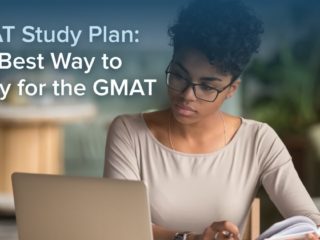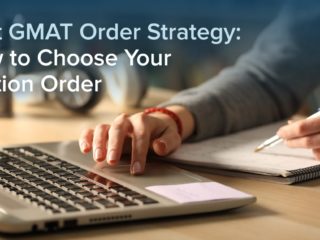| Getting your Trinity Audio player ready... |
It’s no exaggeration to say that your GMAT practice methods can be as important as the GMAT resources and study guides you use to learn concepts for test day. In fact, how you practice can make or break your GMAT preparation.
The thing is, many people prepare for the GMAT extensively without getting the results they seek because their practice isn’t effective. So, in this post, we’ll discuss the best GMAT practice methods for fully and efficiently preparing for test day.
Here are the topics we’ll cover:
- The Goal of GMAT Practice
- How to Practice for the GMAT Early in Your Prep
- How to Practice for the GMAT Late in Your Prep
- Key Takeaways: The Best GMAT Practice Methods
- What’s Next?
Let’s begin by discussing the goal of GMAT practice.
The Goal of GMAT Practice
Unlike most tests we take, the GMAT is not only a test of knowledge or understanding. It’s also a reasoning game. So, the goal of GMAT practice is to develop skill in playing the GMAT game.
There are 3 key aspects of playing the GMAT game:
- understanding what a question is asking
- finding an efficient path to solve the question
- arriving at the correct answer without making any errors along the way
So, when we’re practicing for the GMAT, we’ll seek to develop all these skills.
TTP PRO TIP:
The goal of GMAT practice is to develop skill in playing the GMAT reasoning game.
To properly develop these skills, we need to use different practice methods early and later in our GMAT preparation. So, let’s first take a look at the best way to practice for the GMAT exam early in your prep.
How to Practice for the GMAT Early in Your Prep
At the beginning of GMAT prep, we need to engage in topic-focused practice. This type of practice is the type we’ll do most to prepare for GMAT test day.
TTP PRO TIP:
The bulk of your GMAT practice should be topic-focused practice.
So, let’s take a look at what topic-focused GMAT practice entails.
Topic-Focused GMAT Practice
People preparing for the GMAT often will get the GMAT Official Guide or find other GMAT resources online. Then, they’ll start answering random practice questions one after the other to try to build GMAT skills. This method isn’t efficient or effective.
The main issue with this method is that we often forget what we learned before we see similar questions. As a result, it becomes difficult to apply our knowledge effectively. After all, in between answering similar questions, we’ve answered many questions of other types.
So, a much more effective practice method is to focus on one topic at a time, answering questions on the topic until you’re getting them correct consistently. By focusing on just one topic, you can apply what you learned in answering one question to the next question.
For instance, let’s say you’re focusing on Overlapping Sets questions, and you make an error applying a formula. To avoid that error in the future, you can answer more questions that require using that formula. Thus, you allow yourself to methodically develop skill in each GMAT topic.
In other words, you can master one topic at a time until you’ve mastered the entire GMAT. The TTP GMAT course follows just such a topical learning approach.
TTP PRO TIP:
The most effective way to practice for the GMAT is to focus on one topic at a time.
Start Your GMAT Practice Untimed
Another aspect of GMAT practice that will be important for much of your GMAT prep, and certainly in the earlier stages, is giving yourself sufficient time to answer questions.
GMAT test-takers often believe that they should give themselves only about 2 minutes to answer each practice question. After all, that’s roughly how much time they’ll have per question on the exam..
However, to master the GMAT, the best preparation is not timed practice. Instead, start off doing practice questions untimed. During your practice sessions, give yourself all the time you need to figure out how to answer each question correctly.
As we discussed, the goal of GMAT practice is to develop skill in:
- understanding what questions are asking
- finding paths to correct answers
- avoiding errors along the way
If you do all your practice questions with “GMAT timing,” you won’t have time to develop these skills.
Rather, you’ll rush through questions faster than you can handle them or give yourself an easy out to just give up on questions at the 2-minute mark. Thus, you’ll:
- get a significant percentage of questions incorrect
- rely on answer explanations to find out what you should have done
- continue making the same mistakes because you haven’t developed the requisite skills
On the other hand, if you give yourself all the time you need to fully analyze, understand, and work through each question, you’ll develop strong GMAT skills that will get you to your GMAT score goal.
TTP PRO TIP:
Start off doing practice questions untimed, giving yourself the time you need to fully analyze and work through each question until you arrive at a correct answer.
Practicing for Each Section Untimed
If we’re doing topic-focused, untimed practice, then when practicing for the Quantitative Reasoning, Verbal Reasoning, or Data Insights section of the GMAT, we’ll take all the time we need to carefully read each question and analyze all the answer choices. So, what does that mean exactly?
For Quant questions, we must take the time to determine what mathematical concepts and GMAT strategies to apply. At first, we often won’t be sure how to go about solving a GMAT math practice question. By practicing untimed, we give ourselves time to consider potential approaches until we find one that works. Also, we’ll have time to practice carefully performing calculations without making errors.
For Verbal questions, we have to make sure to solidly support our answers. Moreover, if we’re having trouble choosing between two remaining answer choices, we should stick with the question! Analyze every word in each remaining choice, looking for key differences that make one the more logical answer.
When practicing for the Data Insights section of the GMAT, the biggest hurdle for most students is a lack of familiarity with DI question types. So, we have to give ourselves time to learn each DI question type, its subtypes, and its associated strategies. Although it seems counterintuitive, the most efficient way to build this familiarity is by practicing untimed.
Speed Comes From Skill
If you’re worried that, by practicing untimed, you won’t learn to answer GMAT questions fast enough to complete each section on exam day, keep in mind that skill is what makes you fast. So, by developing strong skills through untimed practice, you’ll be learning to answer questions quickly on GMAT test day.
Later in your preparation, you can focus on developing skill in answering questions quickly. Also, once you’re ready, you can practice answering questions at test pace by taking full-length GMAT practice tests.
Skill is what makes you fast.
The TTP Streaks Method for Confirming Mastery
In doing topic-focused practice, it’s important to confirm your mastery of a topic before moving to the next one.
To confirm topic mastery, we can use the TTP Streaks Method, developed with Dan Cummins, to shoot for streaks of correct answers. The rationale is simple: if you can get questions on a topic correct in long streaks, you’ve mastered that topic.
So, with the TTP Streaks Method, you keep working on a question type until you can achieve long streaks of correct answers.
Let’s take a closer look at how to use this method.
How to Use the TTP Streaks Method
Let’s say you were practicing Assumption questions in GMAT Verbal. You could do easy questions until you got 15 correct in a row. Then you could do medium questions until you got 15 correct in a row. Finally, you could do hard questions until you got 10 correct in a row. This 15-15-10 pattern has been shown to indicate that a test-taker has mastered a GMAT topic.
If you want to earn a top score on the GMAT, you could shoot for longer streaks. For example, consider shooting for streaks of 20 easy, 20 medium, and 15-20 hard questions correct in a row. Or, if you have a relatively modest score goal, you could shoot for 10 easy, 10 medium, and 5 hard questions correct in a row.
Whatever streak lengths you shoot for, the key is to keep working on a topic until you achieve your targets. For instance, let’s say you’re shooting for a streak of 15 medium Ratios questions. If you got 11 questions correct, and then missed 1, you would start over at 0. From there, you would continue to shoot for your streak until you got 15 correct in a row.
TTP PRO TIP:
Use the TTP Streaks Method to confirm your mastery of a GMAT topic.
We now know how to use topic-by-topic, untimed, and streaks practice in the earlier stages of GMAT prep. Next, let’s discuss how to practice in the later stages of your prep.
How to Practice for the GMAT Late in Your Prep
After doing topic-focused, untimed, and streaks practice with hundreds of GMAT Quant, Verbal, and Data Insights sample questions, you should be getting questions correct consistently. Also, you’ll likely be able to answer them fairly quickly.
So, at that point, you’ll be ready to start doing timed practice with mixed question sets. Spend your practice sessions answering mixed sets of Quant questions, mixed sets of Verbal questions, and mixed sets of Data Insights questions. Then, in the final weeks before your actual GMAT exam, you’ll take the official full-length practice tests available on mba.com.
By doing timed practice with mixed sets before you take full-length practice tests, you’ll gain experience answering questions under conditions similar to those you’ll face on GMAT test day.
TTP PRO TIP:
To gain test-like experience, do timed practice with mixed sets of practice questions toward the end of your GMAT preparation.
Key Takeaways: The Best GMAT Practice Methods
What we’ve learned about GMAT practice is the following:
- The goal of GMAT practice is to develop skill in playing the GMAT game, which is a reasoning game.
- The best way to master the various topics that appear on the GMAT is to practice one topic at a time.
- Untimed practice is the best GMAT prep method for developing strong skills.
- The TTP Streaks Method is a great way to ensure mastery of each topic before you move to the next topic.
- To gain test-like experience, do timed practice with mixed sets of practice questions toward the end of your GMAT preparation.
What’s Next?
If you’re wondering “Are practice tests harder than the actual GMAT?” or “How accurate are GMAT practice tests?,” find the answers in our comparison between the actual GMAT and practice tests.
Many GMAT students ask us, “How many practice tests should I take before the GMAT?”
Check out our guide to practice test strategy for the answer to that question and more.
Interested in making your GMAT prep as effective as possible? Schedule a free GMAT tutoring consultation to learn how working with a TTP GMAT tutor can help maximize your performance.



